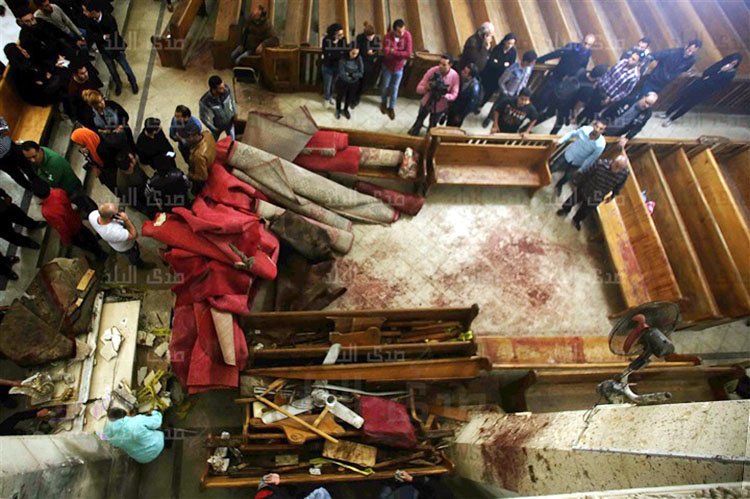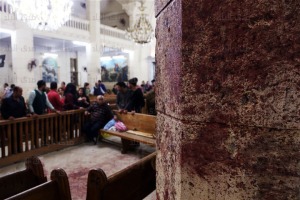
Alexandria – The twin church attacks in Egypt on Palm Sunday (April 9) – one of the holiest days in Christianity – were among the deadliest onslaughts against Coptic Christians in the country in decades.

One attack struck at St. Mark’s Cathedral, the seat of the Coptic Church in Alexandria, where the bomber blew himself up at the church gates. The other struck in the Nile Delta city of Tanta, where the attacker slipped past security to the front benches of the church and blew himself up, turning a religious festivity of joy into a ghastly scene of bloodshed and death.
The Islamic State in Iraq and the Levant (ISIL) has claimed responsibility for the attacks, which left at least 44 people dead. The two suicide bombers have been identified by the Egyptian security authorities. They are Egyptian militants who had fought with DAESH/ISIL in Syria and Libya and had recently slipped back to Egypt.
 Coptic Christians believe their Church dates back to around 50AD, when Apostle Mark was said to have brought Christianity to Egypt. This makes it one of the earliest Christian groups outside the Holy Land.
Coptic Christians believe their Church dates back to around 50AD, when Apostle Mark was said to have brought Christianity to Egypt. This makes it one of the earliest Christian groups outside the Holy Land.
Coptic Christians make up about 10 per cent of Egypt’s population of 91 million. The head of the Coptic Church is the Pope of Alexandria, who had miraculously left the Church minutes before the bombing.
Egypt’s cabinet approved on Monday a decision to impose a nationwide state of emergency for three months starting 10 April at 1 pm.
In a statement issued on Monday, the cabinet explained the reasons for the move.
“The state of emergency allows both the armed forces and the police to execute those procedures necessary to combat the threats of terrorism and its financing, maintain security around the country and protect public and private property, as well as preserving the lives of citizens,” the statement read.
Monday’s approval follows the announcement by Egypt’s President Abdel Fattah El-Sisi late on Sunday that a three-month state of emergency would be imposed in the wake of terrorist attacks on two cathedrals in Tanta and Alexandria during Palm Sunday services.
Following the church attacks, El-Sisi had issued an earlier decree ordering the armed forces to help the police in securing vital facilities all over the country.
According to Egypt’s 2014 constitution, Article 154 stipulates that the Egyptian president can declare a state of emergency, in a manner regulated by law, after consultation with cabinet.
 A state of emergency can only be declared for a stated three-month period, after which it can only be extended with the approval of parliament.
A state of emergency can only be declared for a stated three-month period, after which it can only be extended with the approval of parliament.
The state of emergency grants authorities expanded powers including trying civilians in special courts, restricting or regulating movement in public places, and more authority to regulate media outlets.
Law 162, which regulates the powers of the state under emergency, allows for the trial of civilians before “special” courts, including the “Emergency High State Security Court,” upon orders by the president, who has the right to appoint army officers in the judicial panel of these courts.
Authorities are also granted the right to evacuate or cordon certain areas, as well as specify or restrict means of transportation.
Article 4 of the law grants broader authority to the country’s Armed Forces, including jurisdictional authorities usually reserved for law enforcement bodies.
The law also gives the state the right to impose curfews, though no such plan has been announced by authorities for this most recent state of emergency.

For more articles and videos by Ashraf Ezzat visit his website
The author is an Egyptian, born in Cairo and based in Alexandria. Ashraf Ezzat joined the staff of Veterans Today in 2009.
Graduated from the faculty of Medicine at Alexandria University but keen not to be entirely consumed by the medical profession, Dr. Ezzat invests a lot of his time in research, documentary filmmaking, and writing. He is a regular guest lecturer at the new Bibliotheca Alexandrina and the national museum of Cairo.
History of the ancient Near East and specifically of Ancient Egypt has long been of special interest to him.
In his writings, Ashraf Ezzat approaches ancient history not as some tales from the remote times but as a contributing factor in our existing life; and to him, history is as relevant and vibrant as the current moment.
In his research and writings, Dr. Ezzat is always on a quest trying to find out why the ancient wisdom & spirituality had been obstructed and diminished whereas the Judeo-Christian teachings and faith took hold and prospered.
Dr. Ezzat has written extensively in Arabic tackling many issues and topics in the field of Egyptology and comparative religion.
He is the author of Egypt knew neither Pharaoh nor Moses, a kindle book published in 2015 and available on amazon.
He writes regularly at many well-known online websites such as Dissident Voice and What Really Happened.
Dr. Ezzat is also an independent documentary filmmaker. His debut film was back in 2011 The Annals of Egypt Revolution and in 2012 he made Tale of Osiris a short animation for children.
In 2013 his short film, The Pyramids: Egyptian Genesis
The following documentaries were screened at many international film festivals in Europe.
In 2020 the documentary film: SEA OF LOVE: Transforming Journey to Egypt (Documentary)
In 2021 Egyptian Mountain of the Dead (Documentary)
Dr. Ezzat is working now on his upcoming documentary “Egypt knew neither Pharaoh nor Moses”.
ATTENTION READERS
We See The World From All Sides and Want YOU To Be Fully InformedIn fact, intentional disinformation is a disgraceful scourge in media today. So to assuage any possible errant incorrect information posted herein, we strongly encourage you to seek corroboration from other non-VT sources before forming an educated opinion.
About VT - Policies & Disclosures - Comment Policy



